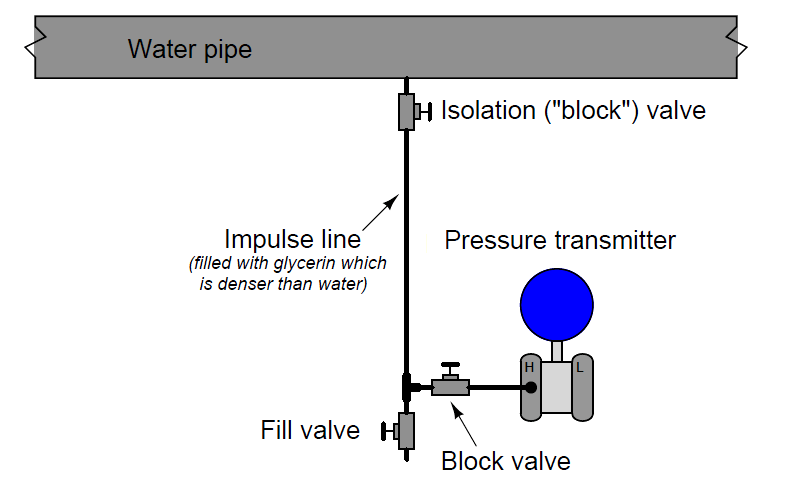An alternate method for isolating a pressure-sensing instrument from direct contact with process fluid is to fill the impulse lines with a harmless fluid, which in turn directly contacts the process fluid. Filling impulse tubes with a static fluid works when gravity is able to keep the fill fluid in place, such as in this example of a pressure transmitter connected to a water pipe by a glycerin-filled impulse line:

A reason someone might do this is for freeze protection, since glycerin freezes at a lower temperature than water. If the impulse line were filled with process water, it might freeze solid in cold weather conditions (the water in the pipe cannot freeze so long as it is forced to flow). The greater density of glycerin keeps it placed in the impulse line, below the process water line. A fill valve is provided near the transmitter so a technician may re-fill the impulse line with glycerin (using a hand pump) if ever needed.
As with a remote diaphragm, a filled impulse line will generate its own pressure proportional to the height difference between the point of process connection and the pressure-sensing element. If the height difference is substantial, the pressure offset resulting from this difference in elevation will require compensation by means of an intentional “zero shift” of the pressure instrument when it is calibrated.
With no isolating diaphragm to separate process fluid from the fill fluid, it is critical that the fill fluid be compatible (Note ) with the process fluid. Not only does this imply a total lack of chemical reactivity between the two fluids, but it also means the two fluids should not be readily miscible (capable of mixing in any proportion).
Note : Truth be told, this is a requirement for all pressure transmitter fill fluids even when isolating diaphragms are in place to prevent mixing of process and fill fluids, because no diaphragm is 100% guaranteed to seal forever. This means every pressure transmitter must be chosen for the application in mind, since modern DP transmitters all use fill fluid in their internal sensors, whether or not the impulse lines are also filled with a non-reactive fluid.
An important consideration in filled-line systems is how to refill the impulse line(s) without damaging the pressure instrument. Hand-operated pumps are commonly used to refill impulse lines, but such pumps are often capable of generating greater fluid pressures than the instrument can safely withstand. If we were to connect a glycerin pump to the filled system pictured previously, it would be advisable to shut the transmitter’s block valve to ensure we did not accidently over-pressure the transmitter. This is especially true if the impulse line happens to become plugged with debris, and substantial glycerin pressure from the hand pump is required to dislodge the blockage:

In fact, the issue of impulse tube plugging is another reason to consider filled-line connections between pressure instruments and process lines or vessels. If ever a plug develops in the line, repumping the lines with fresh fill fluid is a practical way to clear the plug without disassembling any part of the system. For processes where impulse line plugging is a chronic problem, another solution exists called purging impulse lines.
Credits : Tony R. Kuphaldt – Creative Commons Attribution 4.0 License
Also please specify about Hot climate variation in impulse line where temperature here reaches more than 50 deg c.